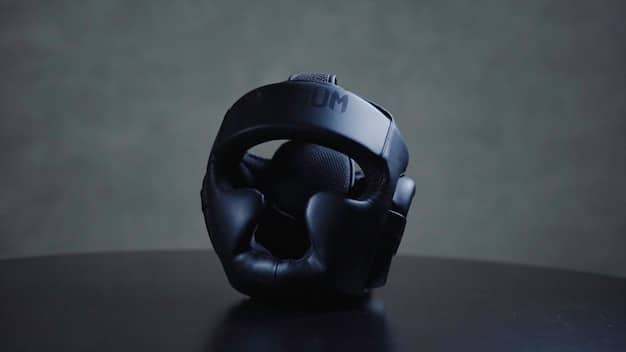The Future of PC Gaming Audio: Spatial Audio & Headset Guide

The Future of PC Gaming Audio is revolutionizing immersive experiences with spatial audio technologies and advanced headset options, offering gamers unparalleled realism and competitive advantages.
The **Future of PC Gaming Audio: Exploring Spatial Audio Technologies and Headset Options** is no longer just about loud explosions; it’s about precise positional awareness, nuanced soundscapes, and a truly immersive experience. Today’s gamer demands more than just sound; they crave a competitive edge, a deeper connection to the game world, and audio that enhances every virtual adventure.
Understanding Spatial Audio in PC Gaming
Spatial audio represents a significant leap forward in PC gaming audio, moving beyond traditional stereo or surround sound to create a three-dimensional soundscape. This technology allows gamers to perceive sounds from different directions and distances, enhancing realism and immersion.
What is Spatial Audio?
Spatial audio simulates how sound behaves in the real world, accounting for factors such as distance, direction, and environmental reflections. This results in a more accurate and believable audio experience, where sounds appear to originate from specific locations around the player.
How Does It Work?
Spatial audio technologies use algorithms to process audio signals and create the illusion of sound emanating from specific points in space. This can be achieved through software-based solutions, hardware-based solutions like advanced sound cards, or a combination of both.
Several key technologies drive the advancement of spatial audio in PC gaming:
- Head-Related Transfer Functions (HRTFs): HRTFs are algorithms that model how the shape of the head and ears affect the perception of sound.
- Object-Based Audio: This approach treats individual sounds as separate objects that can be positioned in 3D space.
- Binaural Audio: Binaural audio uses two microphones to record sound in a way that mimics how humans hear, creating a very realistic spatial effect when played back through headphones.

The impact of spatial audio on PC gaming is profound. It heightens immersion, allowing players to feel more connected to the game world. It also provides a competitive advantage, enabling players to pinpoint enemy positions and react more quickly to in-game events. As spatial audio technology continues to improve, we can expect even more realistic and engaging gaming experiences.
Key Spatial Audio Technologies: A Deeper Dive
Several spatial audio technologies are making waves in the PC gaming world, each with its own strengths and approach. Understanding these technologies is essential for choosing the right audio solution for your gaming setup.
Dolby Atmos for Headphones
Dolby Atmos for Headphones is a software-based spatial audio solution that creates a virtual surround sound experience using any pair of headphones. It simulates the effect of multiple speakers positioned around the listener, providing a more immersive and realistic soundstage.
Windows Sonic
Windows Sonic is a free spatial audio solution built into Windows 10 and 11. While not as advanced as Dolby Atmos, it still offers a noticeable improvement over traditional stereo audio, providing a more immersive and positional sound experience for gamers.
DTS:X Ultra
DTS:X Ultra is another software-based spatial audio solution that aims to deliver a cinematic audio experience through headphones. It uses advanced algorithms to create a wide and immersive soundstage, with accurate positional audio cues.
Comparing these technologies, Dolby Atmos generally provides the most refined and immersive experience, but it requires a paid license. Windows Sonic is a great free alternative, while DTS:X Ultra offers a compelling option for those seeking a balance between performance and cost. The choice ultimately depends on individual preferences and budget.
Choosing the Right Gaming Headset for Spatial Audio
Selecting the right gaming headset is crucial for maximizing the benefits of spatial audio. Not all headsets are created equal, and certain features can significantly impact the overall audio experience.
Headset Features to Consider
When choosing a gaming headset for spatial audio, consider the following features:
- Driver Size and Quality: Larger drivers generally produce a fuller and more detailed sound. Look for headsets with high-quality drivers that can accurately reproduce a wide range of frequencies.
- Frequency Response: The frequency response of a headset indicates the range of frequencies it can reproduce. A wider frequency response generally results in a more balanced and detailed sound.
- Comfort and Build Quality: A comfortable headset is essential for long gaming sessions. Look for headsets with plush earcups and adjustable headbands. Build quality is also important for ensuring the headset will last.
- Microphone Quality: If you plan to use the headset for online gaming or communication, microphone quality is crucial. Look for headsets with clear and noise-canceling microphones.

The compatibility of a headset with specific spatial audio technologies is also important. Some headsets are specifically designed to work with Dolby Atmos, Windows Sonic, or DTS:X Ultra, and may offer enhanced performance with these technologies. Research compatibility before making a purchase.
Top Gaming Headset Recommendations for Spatial Audio
With so many gaming headsets on the market, it can be challenging to choose the right one for spatial audio. Here are a few top recommendations, catering to different budgets and preferences.
High-End Options
For those seeking the ultimate in audio quality and immersion, consider these high-end gaming headsets:
- Audeze Penrose: Renowned for its planar magnetic drivers and exceptional sound quality, the Audeze Penrose delivers a truly immersive spatial audio experience.
- SteelSeries Arctis Nova Pro Wireless: This premium headset offers excellent sound quality, wireless connectivity, and active noise cancellation, making it a top choice for demanding gamers.
Mid-Range Options
For a balance between performance and price, these mid-range gaming headsets offer excellent value:
- HyperX Cloud Alpha: A classic choice for gamers, the HyperX Cloud Alpha provides excellent sound quality, comfort, and durability at an affordable price.
- Logitech G Pro X: This headset offers a comfortable fit, clear microphone, and support for DTS Headphone:X 2.0 spatial audio.
Budget-Friendly Options
For gamers on a tight budget, these headsets offer a solid spatial audio experience without breaking the bank:
- Corsair HS50 Pro Stereo Gaming Headset: A budget-friendly option that doesn’t compromise on sound quality or comfort.
- Razer Kraken X Lite: This lightweight headset offers decent sound quality and comfort at a very affordable price.
These recommendations are just a starting point. It’s essential to research and compare different headsets to find the best fit for your individual needs and preferences.
The Future Trends in PC Gaming Audio
The world of PC gaming audio is constantly evolving, with new technologies and trends emerging all the time. Here’s a glimpse into what the future holds.
Advancements in Spatial Audio Algorithms
Spatial audio algorithms are becoming more sophisticated, offering increasingly realistic and immersive soundscapes. Expect to see further improvements in positional accuracy, environmental effects, and overall audio fidelity.
Integration of AI and Machine Learning
AI and machine learning are playing an increasingly important role in PC gaming audio. These technologies can be used to dynamically adjust audio settings based on the game environment, player actions, and individual preferences, creating a truly personalized audio experience.
Wireless Audio Technologies
Wireless audio technologies are improving, offering lower latency and higher bandwidth. This will enable gamers to enjoy wireless spatial audio without sacrificing performance or audio quality.
The convergence of these trends promises to revolutionize the way we experience PC gaming audio, creating even more immersive, engaging, and competitive gaming experiences.
Optimizing Your PC Audio Settings for Spatial Audio
To fully leverage the benefits of spatial audio, it’s essential to optimize your PC audio settings. Correct configuration ensures the best possible sound quality and positional accuracy in your games.
Configuring Windows Audio Settings
Ensure that your audio output device is correctly configured in Windows settings. Select the appropriate headset or speaker setup, and enable any spatial audio features like Windows Sonic or Dolby Atmos for Headphones.
In-Game Audio Settings
Adjust the in-game audio settings to match your audio setup. Enable spatial audio or surround sound options, and adjust the volume levels of different sound effects to achieve a balanced and immersive soundscape.
Using Equalizers and Audio Enhancements
Experiment with equalizers and audio enhancements to fine-tune the sound to your liking. Some gaming headsets come with dedicated software that allows you to customize the audio profile and create personalized soundscapes.
By carefully configuring your PC audio settings, you can unlock the full potential of spatial audio and elevate your gaming experience to new heights.
| Key Point | Brief Description |
|---|---|
| 🎧 Spatial Audio | Creates a 3D soundscape for immersive gaming. |
| ⚙️ Key Technologies | HRTFs, object-based audio, and binaural audio enhance realism. |
| 🎮 Headset Features | Consider driver size, frequency response, comfort, and microphone quality. |
| 🚀 Future Trends | AI integration and improved wireless audio are on the horizon. |
Frequently Asked Questions (FAQ)
▼
Spatial audio creates a 3D soundscape, allowing you to hear sounds from all directions. This enhances immersion by making the game world more realistic and provides a competitive edge by allowing you to pinpoint enemy positions.
▼
Dolby Atmos for Headphones typically offers the most refined experience, but Windows Sonic is a great free alternative. DTS:X Ultra provides a balance between performance and cost. The best choice depends on your preferences and budget.
▼
Consider driver size and quality, frequency response, comfort, and microphone quality. Also, check compatibility with spatial audio technologies like Dolby Atmos, Windows Sonic, or DTS:X Ultra for optimal performance.
▼
Ensure your audio output device is correctly configured in Windows settings and enable spatial audio features. Adjust in-game audio settings to match your setup and experiment with equalizers for personalized sound.
▼
Future trends include advancements in spatial audio algorithms, integration of AI for personalized audio, and improved wireless audio technologies, promising more immersive and engaging gaming experiences.
Conclusion
The future of PC gaming audio is bright, with spatial audio technologies and advanced headset options offering gamers unparalleled immersive experiences and competitive advantages. By understanding the key technologies, choosing the right equipment, and optimizing your audio settings, you can elevate your gaming experience to new heights.





